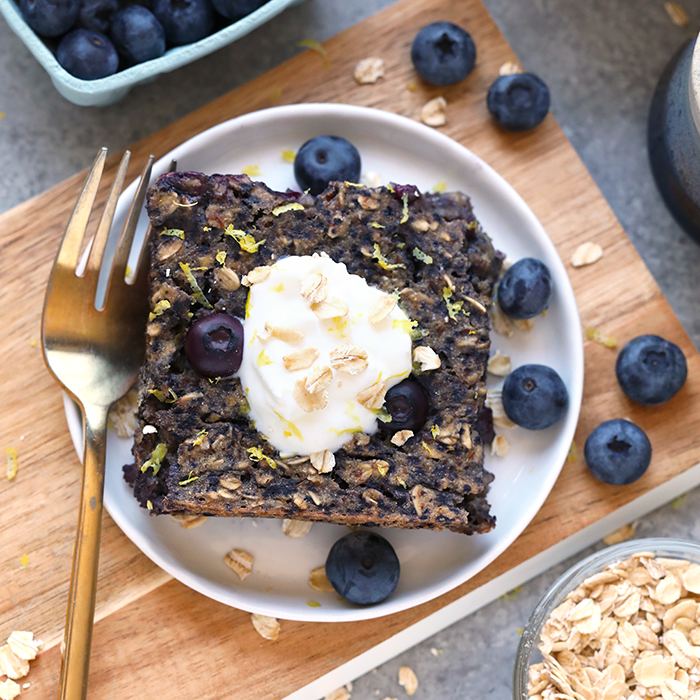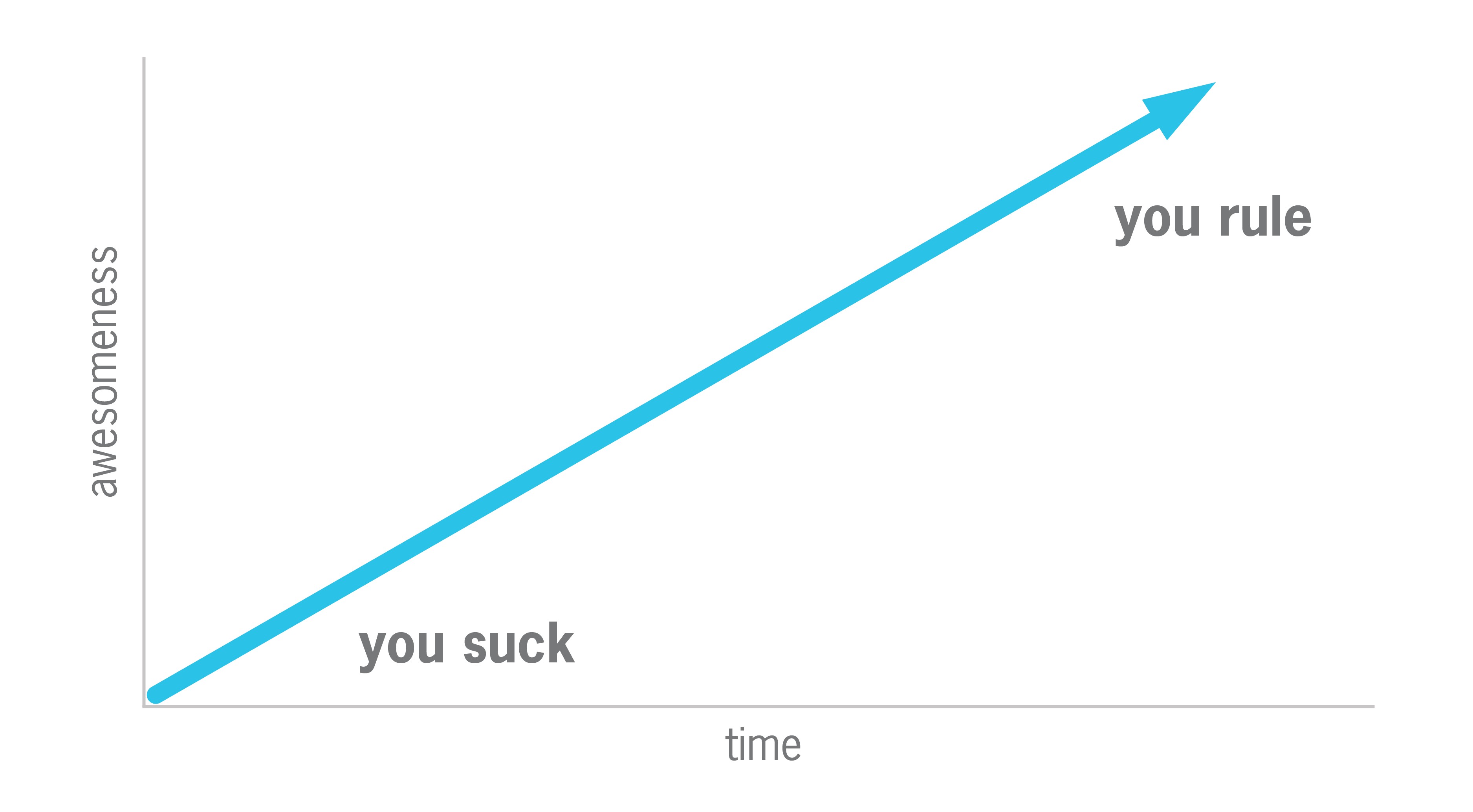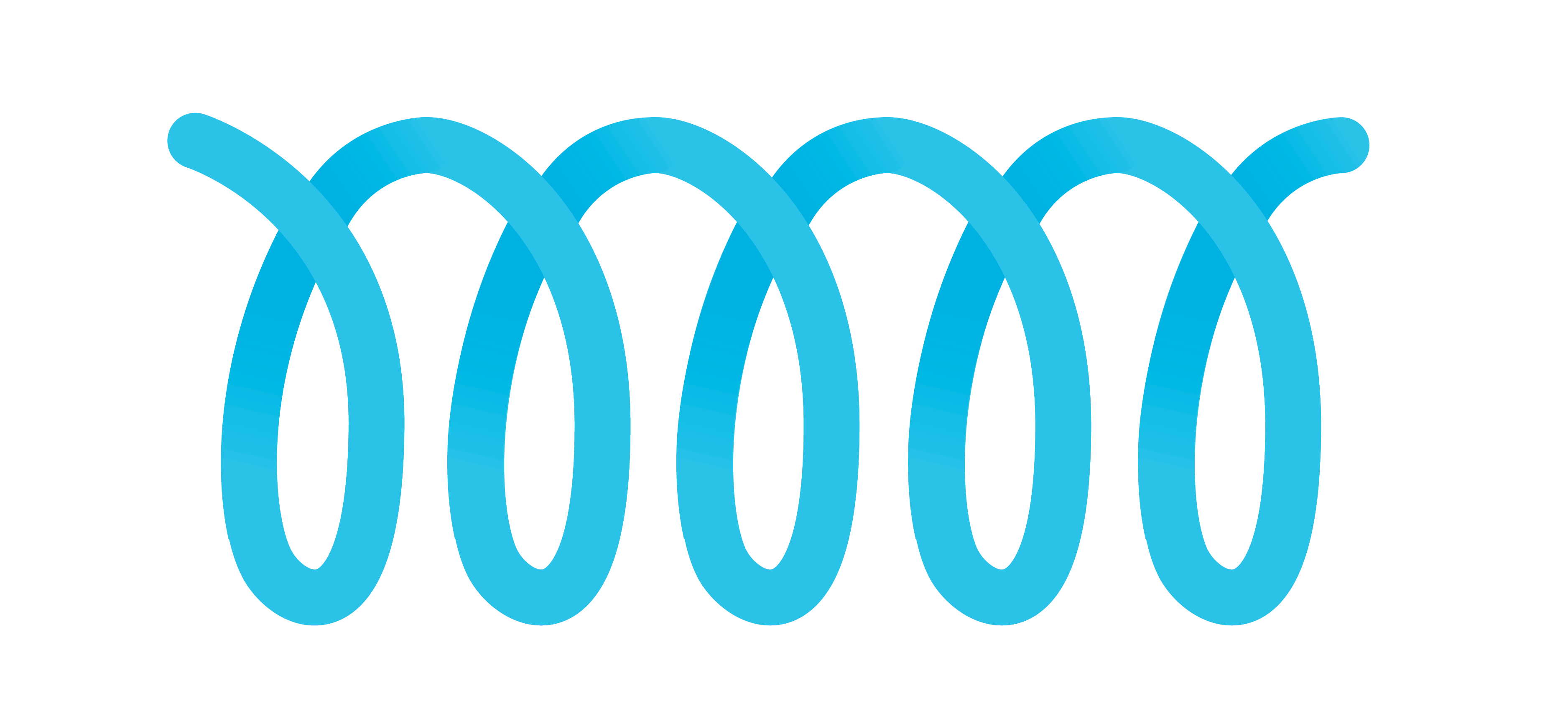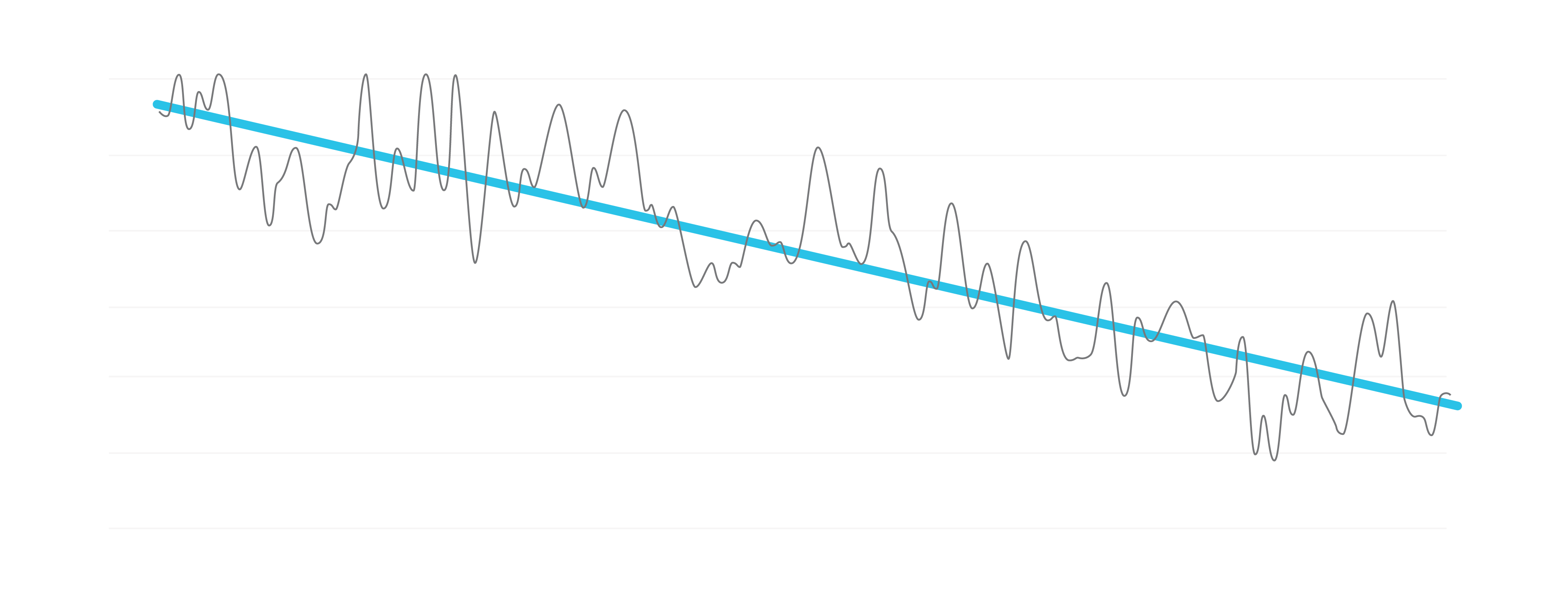Learning more about nutrition is one thing; turning that knowledge into results (and a thriving practice) is another. That’s why, in this article, I share seven proven business models from top health and fitness experts. Use them to grow your existing practice — or to get a new one off the ground.
++++
The fields of health, fitness, and wellness are evolving.
Unless they have a specific problem they need solved, people are no longer looking for ‘personal trainers’ or ‘chiropractors’ or ‘physicians’…
… they’re looking for well-rounded ‘generalist’ coaches who can help them look, feel, and live better, in more holistic ways, and in ways that last.
A big part of that, of course, is eating better.
That’s why modern health, fitness, and wellness professionals are learning more about nutrition than ever before; they’re reading books, taking courses, attending workshops, and getting certified.
But getting the knowledge is one thing; turning it into results (and a thriving practice) it is quite another.
That’s why, when we recently updated and re-opened our Precision Nutrition Level 1 Certification, we added an entire chapter on business, advertising, and marketing (click here to see the table of contents for the course).
It’s also why we put together this article.
In it you’ll learn 7 proven models for adding nutrition coaching to your practice. (Or, if you’re just beginning, how to offer it right from the start). These come from some of the field’s top experts, including: Alwyn Cosgrove, Jonathan Goodman, Sean Greeley, Pat Rigsby, and yours truly.
Here’s a snapshot of what we’ll discuss:
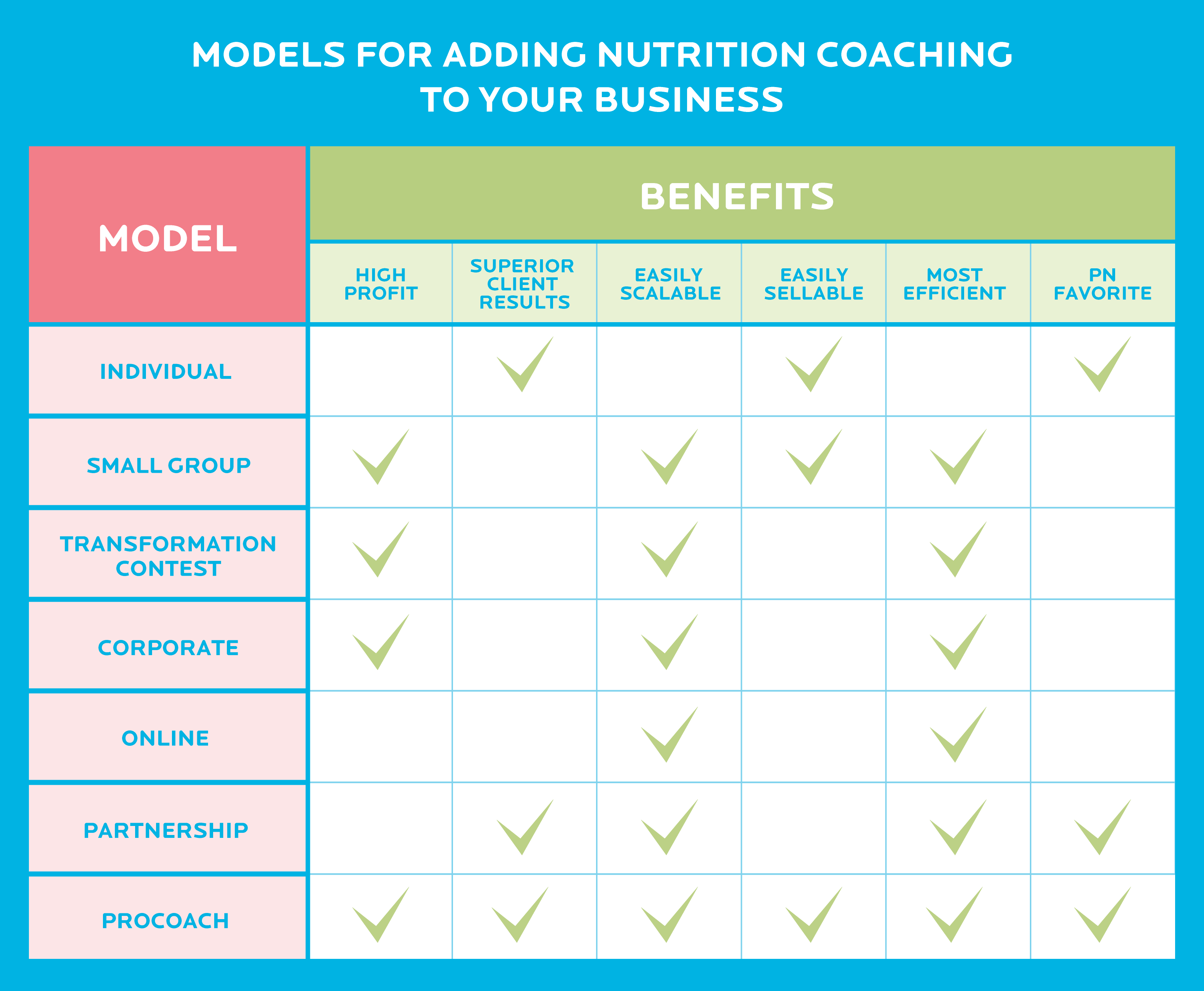
Which model is best for you?
All of the strategies here are proven and expert-vetted — so you really can’t go wrong with any of them.
Still, they all have pros and cons. One model might be a lot more effective for, or better suited to, you (and the people you help) right now.
Feel free to read them all from top to bottom, or just jump to the section most relevant to you by clicking one of the links below.
Individual model
Suggested by John Berardi, Precision Nutrition
For many coaches, working one-on-one with clients and patients is a good start. In the individual model, you present yourself as a well-rounded lifestyle coach — and deliver on that promise.
One of the best ways to do this is to simply build nutrition coaching into your standard package of services.
Step 1: Get a commitment
Ask for the commitment you need to get real, sustainable change. That’s probably at least six months… maybe 12.
Establish an agreement for this duration and bill per unit of time (weekly, monthly, quarterly) instead of per session.
Then, begin your nutrition coaching practice (simply adding it to the exercise, rehab, medical, or other services you’re offering if you’re already in business).
Step 2: Decide how to work nutrition into your one-on-one sessions.
There are two options here.
Option 1: Offer a dedicated, regularly scheduled nutrition session every 1-2 weeks.
Value that session equal to what you’d value the services you’re currently offering. For example, if you charge $100/session for fitness training, you’ll charge $100/session for nutrition coaching.
Option 2: If you’re adding nutrition to an existing business, tack on 15 minutes to each session.
Again, for example, if you’re an exercise coach, do this at the start of the session, before your client is tired.
(Meet in a quiet place. Don’t do this while foam rolling/warming up.)
Of course, factor this extra time into your price per session. For example, if you charge $100 per session, consider charging $125 for a session that includes nutrition assessment and consultation.
(Likewise, if you’re a rehab specialist, or medical professional, you can do something similar.)
At this point, you’re probably thinking: “With a higher price point and a longer commitment, won’t that mean fewer clients or patients?”
Probably not. As current (and prospective) clients/patients see the tremendous value this sort of holistic coaching provides — and begin to see you as an elite-level, well-rounded coach — they’ll be more eager than ever to work with you.
However, even if you did lose a few clients/patients at first (which isn’t likely), you’ll begin attracting folks who are ready for change, and willing to commit.
That means you’ll get better results, and a better shot at establishing a great reputation, not to mention the income that reflects what you’re really worth.
Step 3: Develop your nutrition coaching format.
Here’s an example of what an hour of nutrition coaching might look like, based on the methods we teach in the Precision Nutrition Level 1 Certification:
1. Start with an assessment (if warranted) — check out the ones we use at Precision Nutrition for guidance.
This would involve tracking the things important to your client or patient. It could be objective things like weight, girths, skinfolds, blood parameters, photos and food intake. Or subjective things like mood and perceived health.
2. Review check-in questions.
During the prior week or two, you should have assigned new habits or practices for your clients or patients to work on. Review how they’ve done with those practices, celebrate all successes, and talk through any challenges around those habits.
3. Look back, look ahead.
Most people tend to focus on how far their goals are ahead of them, and how much time, effort, and work still remains. Change their focus by looking backwards and reframing the future as a set of opportunities.
Review what they’ve accomplished and what they’re currently excited about or looking forward to:
Looking back over the last xx days, what are you most proud of?
Today, what are you most excited about?
Looking forward, what are you most confident about for the next xx days?
4. Establish the next practice to work on.
Together with your client or patient, collaborate on what to do next. As part of your decision-making process, consider their progress, their changing goals, current sticking points, and what feels most important and/or urgent to them.
Once you agree on next actions, ask: How confident are you that you can follow this for the next xx days? Adjust as necessary until you come up with something you think will make a difference and they think they can actually do.
5. Create a plan/discuss next steps that will set them up for success.
Based on what we decided to practice over the next xx weeks…
What advantages do you have that’ll make this easy?
What surprises or challenges may come up and get in the way?
What sort of things might you do to overcome these challenges?
Top benefits of the individual model:
Easy to get started. If you have training clients or rehab patients, you have potential nutrition clients or patients too.
Keeps the scale small and manageable. This is a great place to start if you don’t feel ready for large-scale coaching, or if you’re simply happier coaching people one-on-one.
Simple integration with existing services. You’ll still be leaps and bounds ahead of the run-of-the-mill coaches out there because you’ll be coaching people to better, lasting change. You’ll have real results to show for your efforts — and you’ll be able to charge for it.
Small group model
Suggested by Alwyn Cosgrove, Results Fitness University
Unlike the individual model, the small group model lets you coach several people simultaneously in the same session. The sessions are held at a regular, recurring time, and everyone works together. Usually, there’s also a finite end point (such as an 8-week or 12-week program).
This is also a nice way to make the most of your time. You’re spending an hour (or whatever) regardless; 10 people paying $20 each will yield twice the revenue of 1 client paying $100 for that same hour.
Clients/patients may also prefer to trade off one-on-one time for a cheaper price — or simply like the idea that they’re sharing the journey with others.
Step 1: Add nutrition classes to your existing business.
If you have existing clients or patients, you can suggest that for an additional fee, they join your small group nutrition class.
Step 2: Consider “front-loading” nutrition for new clients.
Encourage uptake of the nutrition program by offering a free “entry level” nutrition starter class or kit when a client or patient begins working with you.
For example, at Results Fitness, every new client gets a “Phase 1” nutrition program that includes some initial habit-based coaching with bonus tools (like a food journal).
From there, Cosgrove estimates that 90% of clients upgrade to the 8-week small group program.
Feel free to experiment and discover the “winning formula” that works for your own coaching style and client or patient base.
Step 3: Develop your nutrition class.
What should the classes look like?
Class size can vary depending on your group and comfort level. However, generally 5-25 people per nutrition class is ideal.
The class structure could look something like this:
- 30 minutes lecture on a given topic
- 15 minute Q & A
- 15 minute check-in and accountability session
Step 4: Find a good system for tracking compliance.
Accountability generally involves reviewing whether the client or patient has met their stated goals from the last session; and identifying what they will commit to work on for the next period of time.
The coach can assign the same habit to everyone, or allow each person to choose their own habit for the week, based on what they’re learning and their progress in the program. (Perhaps take a certain supplement each day or practice eating slowly at dinner time.)
Straightforward ways to track compliance include:
Have clients/patients sign a visibly placed whiteboard. By doing so, they’re committing to the week’s habit.
Keep a “compliance grid”. Throughout the program, track each individual’s consistency: If they miss a habit, they get an X; if they do the habit, they get the checkmark.
Assign “accountability buddies”. This allows people to partner up so they may check in with each other about their progress.
Top benefits of the small group model:
Return on investment: You maximize your profitability without investing more time. Serving more people at once, even at a lower rate than an individual hourly model, will allow you to increase profits per unit of time spent.
Accountability: For many people, the biggest barrier to success isn’t knowledge, it’s consistency. And consistency can be helped tremendously by accountability — something that naturally flows from having other people check in on your progress week after week.
Social support: We also know people are more likely to stick with the program if they have peers, friends or family with similar habits. A group model can provide a community feel and give folks a sense of support. They’ll keep coming back (and re-subscribing to your program) because they want to remain a part of the community.
Transformation contest model
Suggested by Pat Rigsby, patrigsby.com
In a transformation contest model, you provide coaching within a limited time frame (about 4 to 6 weeks), with a very clear goal. The contest offers a prize for a particular achievement, such as:
- body composition changes
- visual transformation
- habit transformation
- athletic accomplishment
- etc.
Step 1: Develop and advertise the contest.
Decide on the criteria and find an enticing prize to draw people in. (Note: You will likely need a sponsor for this prize, especially if you’re not part of a fitness club or larger organization.)
Set a registration fee you’re comfortable with. $225 is a typical starting point.
Now, of course, to make a good contest, you need plenty of people. While you can have as many people as you like, to make it sporting I recommend about 20 people as a minimum.
Step 2: Offer ongoing coaching and accountability.
Throughout the pre-specified time frame of the program, you’ll deliver a combination of email coaching and in-person (or online) educational workshops. For example, you might send out a new email every Monday with that week’s program (i.e. exercise and nutritional habits), plus follow-up emails throughout the week.
In addition, you might host weekly in-person workshops or webinars throughout the program that discuss nutritional habits in more detail.
You may also choose to set up an online group, such as a private Facebook group, where you can send a daily reminder or “check-in” asking people to confirm they did their daily habit. This helps to build accountability into the program.
Step 3: Objectively measure results.
For instance:
- If the goal is physical transformation, set times for in-person measurements throughout the program.
- If the goal is athletic achievement, set times for group workouts or “fitness tests”.
Make sure criteria and measurements are clear and transparent. You don’t want people feeling misled or shortchanged.
While the program is short, it enables you to offer a lot of value in a short period.
Top benefits of the transformation contest model:
Creates urgency: The short time frame with specific set dates encourage people to make a commitment.
Highly motivating; keeps people focused: People can see real change within a short time frame, with a set endpoint. They can go “all in”, with an intense and focused effort.
Immediate cash influx and long-term financial benefit: You’re both enhancing the value of existing clients or patients by getting them to pay for a new service, and bringing in new clients/patients or who may sign up for other programs with you.
Enables you to deliver nutrition coaching and fitness/health/rehab coaching together in a structured way. This may be a good model if you want to incorporate some nutrition coaching into your work but aren’t ready to transfer it to your standard programs.
Corporate model
Suggested by Sean Greeley, Net Profit Explosion
In the corporate coaching model, you’ll provide nutrition coaching to a workplace (either a whole company or a specific department).
Corporate demand is increasing. It’s a great way to scale up your business and sell your services at a higher corporate rate.
It’s also mutually beneficial: Employees appreciate getting access to quality nutrition coaching and employers love the corporate culture and team-building benefits while improving the health of their employees.
Step 1: Get comfortable coaching large groups of people.
Get some experience with the group setting by starting with the small group or transformation contest model.
Step 2: Decide on the format of your nutrition coaching program.
For corporate clients, you’ll need to make a few amendments to your existing model, but you can borrow many of the same practices of either the small group program or the transformation contest program, depending on company size.
Top benefits of the corporate model:
High profits: Corporate coaching programs usually come with a higher price tag. Just be sure you can deliver on your promises. They will expect good service.
Less investment of time and administration: Corporate programs don’t need the marketing or sponsorship of free-standing transformation contests. This makes things more efficient (and potentially more profitable) for you. Transformation contests can be a bit heavy on logistics. Within a company environment, they become much more straightforward.
Broader audience: A corporate program can give you access to a large group of people (e.g. 100+), allowing you to sell/upgrade more clients or patients after the program is complete. (This assumes you have their permission to do so.)
Online coaching model
Suggested by Jonathan Goodman, The Personal Trainer Development Center
Online coaching typically involves weekly programming (by email or a software service), which may include written, photo and/or video content. It will require a degree of one-on-one time from you to provide accountability or answer questions, but that time should be structured and limited, as described below.
Step 1: Choose how many people you want.
Your goal number of clients/patients should depend on what you are trying to accomplish. Are you starting an online-only business? Is this supplemental to other projects, or will it be your primary work?
If it’s supplemental, or you’re just getting started, you may choose to begin with a small group (e.g. 10 to 20) and a small price point ($100/month).
Up to around 30 or 40 people seems to be manageable without special software. Beyond that point, you may wish to use a special software system to help manage clients/patients and content delivery.
Step 2: Choose your specialty or “niche”.
Efficient online nutrition coaching requires you to focus and establish templates for client/patient “type”. Pick no more than 3 types of individuals you want to include in your online program.
For example:
- 25-30-year-old males looking to build muscle
- Women in their 30s who recently had a baby
- 60-75-year-old retirees
- etc.
Step 3: Assess your prospects in advance.
Ask prospects to fill out a questionnaire. You can set up a simple survey online using a system such as Survey Monkey.
This will not only help you vet clients/patients to make sure they fit your area of specialty, but also to anticipate needs and problems in advance.
(For example, if you’re doing fitness coaching and clients have a shoulder injury, you will need to adjust their workouts accordingly.)
Step 4: Create 3-4 phases of programming for each type.
Each client/patient in the same category will receive a similar program, tailored slightly for them, based on their questionnaire answers.
Step 5: Set appointed times for compliance check-ins.
For example, at the end of the week, the client/patient can send you their food journal, or their update on what habits they kept, etc. You can schedule a time to review your email and check off compliance using your favorite method (e.g. a whiteboard or spreadsheet).
Schedule your time carefully. Set up regular appointments for yourself for when you will send materials, when you will check email or conduct accountability check-ins, schedule follow-ups, etc.
Step 6: Consider software.
Once you get a broader scope of clients/patients, you may look at buying software to help you deliver nutrition coaching materials.
Unfortunately not all software services support nutrition coaching. If you’re going the software route, be sure to speak with a representative about nutrition coaching in advance to make sure it has the functionality you need.
[Editor’s note: Precision Nutrition’s ProCoach is just this type of nutrition coaching software. It allows health, fitness, and wellness professionals to leverage our proven methods with their own clients/patients.]
Top benefits of the online coaching model:
It can save you time and money… if you do it right. Remember, online coaching doesn’t have to be a big business; it can be a great adjunct to an existing in-person business. For example, if you are training at a gym and want to try combining nutrition coaching with fitness, this can be a good way to do that on the side.
Client adherence can actually be better. Think about it: At a big rehab center, the client/patient buys “rehab” instead of a particular therapist. Since the therapist is often chosen for them, they may not be a good fit — and the client/patient feels no sense of agency in the decision. On the other hand, when you’re an online coach, the client picks you.
You reach the people who need you. Online coaching is a great way to reach people who need the help. For example, there are people who can’t afford gym memberships or personal training, or who are intimidated by gyms. Online coaching makes getting the help they need more accessible.
More flexibility. Online coaching can give you more freedom for how and when you work, allowing you to block off time according to your own schedule and use your preferred ways of working.
Just remember, in order to save you time, you must work efficiently and systematically. If you’re redesigning your programs for each and every person, and answering email all day long, you’re probably not going to get the results or profit you hoped for.
Partnership model
Suggested by John Berardi, Precision Nutrition
What if you’re not quite ready to provide nutrition coaching within your business?
No problem. You can outsource it.
The truth is, some coaches who are qualified to dispense nutrition advice (including Precision Nutrition Certified pros) decide that now isn’t the right time to formally incorporate practice-based nutrition coaching into their business.
That’s a fair decision. After all, it takes time to make any kind of addition or change to your business. It takes time to put all this nutrition stuff into practice, let alone become an expert at it. And it takes time to settle into your sweet spot of expertise, wherever you find it.
Meanwhile, you want the best for your clients or patients. You don’t want them getting lost in diet fads or repeating harmful patterns. You want them to feel good and succeed, in all areas of health and fitness.
So let’s say you decide that, at least for the time being, you’d like some help delivering nutrition coaching. This is where a partnership model can be useful.
Step 1: Start by picking your partner.
This may be a local nutritionist or dietitian who you trust and respect. Or it may be a reputable online coaching company, like us. (Obviously, at Precision Nutrition, we believe we’re the best in the world at what we do. So perhaps you want to partner with us? If so, drop us a line and let us know.)
Step 2: Decide on your partnership arrangement.
If you’re teaming up with a local nutrition pro, figure out what works best for the both of you: Will you exchange referrals? Go with affiliate-type commissions? Come up with a barter system?
There are lots of options, although my experience suggests that affiliate/referral commissions work best. With affiliate commissions, you determine a commission rate. Your affiliate partner pays you that rate for each person you refer to them. (And vice versa if they’re referring clients/patients to you.)
This type of revenue sharing model is commonly used in the digital/online world but there’s no reason it can’t be done offline too. Obviously, you can negotiate whatever you agree is fair, but a commission of 10 to 20 percent on each coaching package sold is standard.
For example, let’s say you decide you want to partner with us. As a Precision Nutrition Certification student or graduate you can become a referral partner of ours. You contact us, sign up for our affiliate program, and you’re given a special link to share with clients or patients for them to learn more about Precision Nutrition Coaching.
For each client/patient you think is a good candidate, you share that link with them. And if they go on to sign up for coaching, you get paid a generous percentage of the sale.
This is just an example, of course. You could set up a similar relationship with any other nutrition coach or nutrition company you choose, as long as they’re amenable.
The key is to make sure they’re giving advice you actually believe in, so that your clients/patients aren’t receiving mixed messages and getting confused.
Step 3: Stay in touch about their nutrition coaching.
For example, you might schedule regular check-ins to see how it’s going, what habits they’re working on, etc.
Just stay informed so you have a sense of their progress and so you can make sure your work dovetails with what’s happening on the nutrition side.
Top benefits of the partnership model:
You can take care of your clients/patients. If you aren’t ready or able to offer nutrition coaching right now, you’ll know they’re getting quality support in this area. Part of being a great coach is knowing when to call in extra resources to help your people succeed. Not everything needs to come from you.
You buy yourself some time. Keep working in the areas where you’re already a superstar. Meanwhile, keep learning and practicing in areas you want to grow. Remember, you don’t have to do everything all at once.
You keep it simple. Like your business the way it is now? Not excited about adding or changing things? Outsourcing is an easy solution.
You make a bit of money, and/or find some new clients/patients. Partnership can open up new opportunities and it can even make you some cash, with very little investment on your part.
Precision Nutrition’s ProCoach
As an addition, or alternative, to the models above, you may consider using Precision Nutrition’s ProCoach software, which offers Precision Nutrition Certification students and graduates an easy way to deliver the practice-based nutrition coaching we teach in our program.
In this model, ProCoach delivers the Precision Nutrition Coaching curriculum to your clients and patients, while keeping you in the driver’s seat as the coach.
You sign up your clients/patients, and ProCoach runs automatically for each person.
Each of your clients will get 12 months of lessons, habits and progress check-ins, delivered to them automatically on your behalf. Meanwhile, ProCoach gives you a platform to track their progress.
While ProCoach delivers the programming, you are the coach. That means you can help your clients/patients through the curriculum in whatever way you choose — whether that’s in person, entirely online, in a group setting in the gym, a corporate setting, and so on.
Here’s an idea of how this works.
Step 1: Get started on (or complete) your Precision Nutrition Certification.
Again, ProCoach is only available to Precision Nutrition Certified professionals.
Step 2: Sign up for ProCoach.
We’ll be making more spots available soon. Click here to check out our next launch date.
Step 3: Register your clients/patients for the program.
This takes less than 30 seconds per person. The program immediately kicks off and gives your client/patient access to their personal dashboard, from any device.
Step 4: Review their assessment answers.
The program begins with an initial screening and assessment questionnaire. You can then review client/patient responses to get to know more about them and understand their goals.
Step 5: Let the program run.
At this point, the program runs like clockwork. Folks get daily emails with short reviews and lessons about what they should be working on that day. Every two weeks they will practice a different habit, supported by daily guidance in the form of written, audio, and visual content.
Step 6: Review client progress.
Every week or two, clients/patients are asked to report markers of progress such as body weight and photos. Through your ProCoach dashboard you will be able to review progress. You can easily track everyone at a glance, and deep dive into each individual’s progress as you wish.
Step 7: Check in and provide feedback.
If you want to be more involved, you can check in, provide feedback, and give high fives through the ProCoach communication system. Depending on your coaching style, you can also add your own personal elements to this — such as in-person coaching, group meetups, webinars, etc.
Top benefits of the ProCoach model:
Provide a reliable nutrition coaching experience. You’ll deliver the same high quality nutrition coaching experience to every single client/patient regardless of what else is going on… in your life or theirs. ProCoach offers our “road-tested”, evidence-based, real-world-proven system and experience for everyone. We’ve put some serious mileage on it so we know it works.
Scale up. (The sky’s the limit.) You’ll be able to coach 5 clients, 50 clients, or 500 people easily — because ProCoach makes it simple. We’ve already coached nearly 100,000 clients using this very system. Think you can handle that many clients? Go for it. The system will work, whether you have 10 people or 10,000.
Automation makes it easy. You’ll be able to deliver nutrition habits, lessons, and assignments on time and on track, no matter what else you’re doing. Whether you’re sleeping, busy, out of town, in bed with the flu, stuck in traffic or on a plane somewhere above the Pacific ocean… it doesn’t matter. You don’t have to be there all the time, or married to your laptop, always wondering and worrying. The system will take care of your people, and make sure they get what they need. Daily, weekly, and monthly check-ins and progress tracking are also automated.
What to do next:
Some tips from Precision Nutrition
Whether you’re already in the middle of your coaching career or you’re just starting out, getting a top-notch nutrition education is the most important (and first) step.
Then you’ll need smart tools and systems for using that knowledge to get the best results for your clients/patients — and for your business.
In this article, we’ve offered lots of ideas for adding nutrition coaching to your practice. It can sometimes feel overwhelming. But starting with these steps will help you stay focused.
1. Know your stuff.
The business models we’ve laid out in this piece only work if you truly know your stuff. For example: If you’re going to coach nutrition, make sure you understand the fundamentals.
And just like nutrition, business is an ongoing learning process, too. Do you know the essentials of sales and marketing and buying psychology? Can you express what you do with clarity and passion? Do you know how to demonstrate authority and build a top-notch reputation for yourself? These may be areas where more study is needed to raise your game.
Take an honest assessment of where you are now as a coach and a business person. Where are your gaps?
Of course, if you don’t have the fundamental nutrition knowledge yet, maybe it’s time to get your Precision Nutrition Level 1 Certification. It’ll boost your credentials and up your game. Plus, once certified, you can use ProCoach.
2. Value your time and your services.
It may be tempting to give your nutrition knowledge away for free. Clients, patients (and friends and family) may ask you to do so, without giving it much consideration.
But if you want to make a great living, you need to put a price on your nutrition coaching services — whether that’s an increased hourly rate or a special program.
You also need to value your own time. The adage “time is money” is particularly true for health, fitness, and wellness. Be clear and specific about when you’re available, and how the time will be used.
You can also apply my ‘1-minute rule’. If you can answer the question in less than one minute, go for it. If you’ll need more than that, it falls under the umbrella of coaching — and that means you charge for it.
3. Use a system.
Nutrition coaching really isn’t something you can wing. The best, most effective, way to use your knowledge — for the good of your clients/patients and your business — is to have a system in place.
As you consider which business model to use, consider your goals and preferred way of working.
Do you feel most inspired when interacting with people one-on-one? Do you love the group setting because of your passion for public speaking? Are you pressed for time, making the online option most practical for you? Do you need to work with a partner or other third party for now, while you refine your nutrition knowledge and coaching skills?
All of these options have their own pros and cons; there is no single “right” way to do things.
It may take some experimentation before you find what works best for you. Start by picking one system, and giving it a try. As you go, you’ll learn from your mistakes, discover what works best, and adapt accordingly.
4. Get some support, if you need it.
You don’t have to do everything all by yourself, or all at once. If you’re not quite ready to provide nutrition coaching, you may consider a partnership model.
Or, if you want to provide nutrition coaching but want an easy and reliable delivery method and a tried-and-tested curriculum, explore Precision Nutrition’s ProCoach.
If you’re not sure which way to go right now, you can always reach out to us at Precision Nutrition — we’re happy to help.
5. Above all else, fulfill your promise.
Remember why you’re doing this in the first place — you’re passionate about health, fitness, and nutrition, and you want to use that passion to help people.
Your success fundamentally depends on the value you deliver. If people hire you because they want to live better, healthier lives, it’ll be your job to help them do that.
That’s the biggest reason nutrition coaching belongs in the health, fitness, and wellness spaces. It’s also why you have the potential to be immensely successful in these fields. Because if you deliver on the promise to help people live and feel better, you will stand out, and you will be successful.
Passionate about nutrition and health?
If so, and you’d like to learn more about it, consider the Precision Nutrition Level 1 Certification. Our next group kicks off shortly.
What’s it all about?
The Precision Nutrition Level 1 Certification is the world’s most respected nutrition education program. It gives you the knowledge, systems, and tools you need to really understand how food influences a person’s health and fitness. Plus the ability to turn that knowledge into a thriving coaching practice.
Developed over 15 years, and proven with nearly 100,000 clients, the Level 1 curriculum stands alone as the authority on the science of nutrition and the art of coaching.
Whether you’re already mid-career, or just starting out, the Level 1 Certification is your springboard to a deeper understanding of nutrition, the authority to coach it, and the ability to turn what you know into results.
[Of course, if you’re already a student or graduate of the Level 1 Certification, check out our Level 2 Certification Master Class. It’s an exclusive, year-long mentorship designed for elite professionals looking to master the art of coaching and be part of the top 1% of health and fitness coaches in the world.]
Interested? Add your name to the presale list. You’ll save up to 33% and secure your spot 24 hours before everyone else.
We’ll be opening up spots in our next Precision Nutrition Level 1 Certification on Wednesday, April 4th, 2018.
If you want to find out more, we’ve set up the following presale list, which gives you two advantages.
- Pay less than everyone else. We like to reward people who are eager to boost their credentials and are ready to commit to getting the education they need. So we’re offering a discount of up to 33% off the general price when you sign up for the presale list.
- Sign up 24 hours before the general public and increase your chances of getting a spot. We only open the certification program twice per year. Due to high demand, spots in the program are limited and have historically sold out in a matter of hours. But when you sign up for the presale list, we’ll give you the opportunity to register a full 24 hours before anyone else.
If you’re ready for a deeper understanding of nutrition, the authority to coach it, and the ability to turn what you know into results… this is your chance to see what the world’s top professional nutrition coaching system can do for you.
The post 7 proven + profitable models for adding nutrition coaching to a health and fitness business. Help more people and build a thriving practice with these expert tips. appeared first on Precision Nutrition.
from Blog – Precision Nutrition https://www.precisionnutrition.com/adding-nutrition-coaching-to-business
via
Holistic Clients







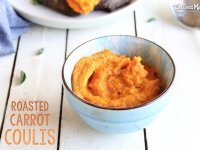


 When it comes to yoga, meditation and even me-time in general, we can sometimes worry we are being a little selfish. Dedicating time to our own wellbeing can feel overly indulgent, and there’s even a creeping suggestion self-care is little more than an excuse for self-absorption. Dr Alison Gray, of the Royal College of Psychiatrists, has warned that “inward-looking” spiritual practices (like meditation) can make us more selfish – but is this actually true?
When it comes to yoga, meditation and even me-time in general, we can sometimes worry we are being a little selfish. Dedicating time to our own wellbeing can feel overly indulgent, and there’s even a creeping suggestion self-care is little more than an excuse for self-absorption. Dr Alison Gray, of the Royal College of Psychiatrists, has warned that “inward-looking” spiritual practices (like meditation) can make us more selfish – but is this actually true? Editor’s note: This is a guest post from Holly Ashby. Holly is a wellness writer who has worked with the London meditation center
Editor’s note: This is a guest post from Holly Ashby. Holly is a wellness writer who has worked with the London meditation center 





